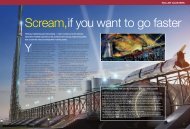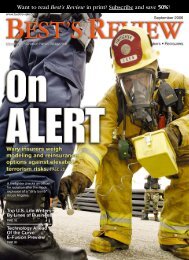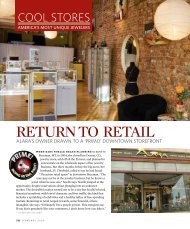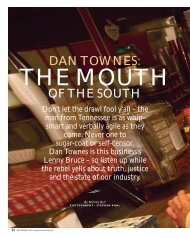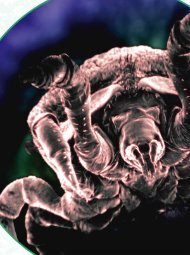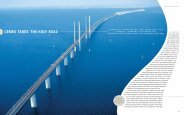SIngaPore'S MarItIMe r&D lanDSCaPe IS a rICh anD DIverSe ... - tabpi
SIngaPore'S MarItIMe r&D lanDSCaPe IS a rICh anD DIverSe ... - tabpi
SIngaPore'S MarItIMe r&D lanDSCaPe IS a rICh anD DIverSe ... - tabpi
Create successful ePaper yourself
Turn your PDF publications into a flip-book with our unique Google optimized e-Paper software.
Feature<br />
maritime r&D<br />
singaporenautilus 4Q 2011<br />
10 11<br />
Singapore’s maritime R&D landscape is a rich and<br />
diverse one, and helps drive the local maritime<br />
cluster towards innovation and greater heights.<br />
BY Vincent wee<br />
Photography Alvinn Lim<br />
Corporations and<br />
governments around the<br />
world spend a good deal<br />
of effort and resources on<br />
research and development<br />
(R&D), knowing that the fruits<br />
of R&D can lead to innovative<br />
solutions and competitive<br />
advantages. For Maritime<br />
Singapore, many players<br />
join hands to drive R&D in<br />
maritime to greater heights.<br />
The industry, tertiary and<br />
research institutions, and the<br />
government work together to<br />
secure the future by ensuring<br />
that Singapore stays on top of<br />
all the technological advances<br />
that are taking place in the<br />
maritime sector.<br />
It is in this context that the<br />
R&D framework put together<br />
by the Maritime and Port<br />
Authority of Singapore (MPA)<br />
becomes significant. The<br />
framework helps focus R&D<br />
efforts within Singapore’s<br />
diverse maritime cluster<br />
and provides the tools and<br />
settings to turn Singapore<br />
into an international centre of<br />
excellence for maritime R&D.<br />
The R&D framework is<br />
developed around a value<br />
chain that involves four<br />
areas: education and training<br />
to develop R&D expertise;<br />
generating intellectual<br />
property and results; testbedding<br />
for prototypes from<br />
R&D; and commercialisation<br />
of the developed products<br />
and services.<br />
Linkages with tertiary<br />
and research institutions<br />
and the maritime industry<br />
form the backbone of the<br />
framework. The National<br />
University of Singapore’s<br />
(NUS) Offshore Technology<br />
Research Programme (OTRP),<br />
the Nanyang Technological<br />
University’s (NTU) Maritime<br />
Clean Energy Research
Feature<br />
maritime r&d<br />
singaporenautilus 4Q 2011<br />
12 13<br />
Programme (MCERP) and the<br />
Institute of High Performance<br />
Computing (IHPC) are the<br />
marquee initiatives thus far.<br />
Funding<br />
The meat on the bones of the<br />
R&D framework is MPA’s $100<br />
million Maritime Innovation<br />
and Technology (MINT) Fund.<br />
This is the means through<br />
which MPA implements the<br />
schemes and programmes<br />
under this framework and<br />
aims to meet the needs of the<br />
maritime industry within the<br />
Singapore maritime cluster.<br />
Port, shipping, and offshore<br />
and marine engineering have<br />
been earmarked as the three<br />
main sub-clusters within the<br />
local maritime cluster that<br />
R&D efforts have been<br />
geared towards. To this<br />
end, funds and efforts are<br />
appropriately channelled<br />
between various organisations<br />
and research bodies to best<br />
achieve these goals.<br />
Port development<br />
Singapore’s two port operators,<br />
PSA and Jurong Port, are the<br />
epicentre around which the<br />
entire maritime leadership<br />
is based. Both are working<br />
towards developing new<br />
technologies. Under the Port<br />
Technology Research and<br />
Development Programme,<br />
MPA and PSA are collaborating<br />
to conduct research and test<br />
new technologies for future<br />
container terminals.<br />
SHIPPING<br />
º Ship Management Services<br />
º Ship Broking & Chartering Services<br />
º Shipping Lines / Ship Owners<br />
º Ship Agency Services<br />
º Cruises<br />
PORT<br />
º Cargo / Passenger Terminals<br />
º Ship Chandlers<br />
º Ship Bunkering<br />
º Inland Water Transport<br />
The five-year programme<br />
focuses on three broad<br />
areas, namely automated<br />
container port systems,<br />
advanced container port<br />
optimisation techniques and<br />
technologies, and green port<br />
technologies. The programme<br />
will see MPA, PSA, equipment<br />
and technology providers,<br />
local institutions and other<br />
companies coming together<br />
to develop advanced port<br />
technologies for Singapore’s<br />
container terminals.<br />
MPA is funding the<br />
Programme with up to $10<br />
million over five years from the<br />
MINT Fund. PSA, together with<br />
local institutions and other<br />
industry partners will provide<br />
co-funding and resources of<br />
up to $10 million over the<br />
same period.<br />
Jurong Port, meanwhile,<br />
is working with MPA in the<br />
Green Port and Productivity<br />
Solutions Programme.<br />
Co-funded by MPA’s MINT<br />
Fund and Jurong Port, the<br />
programme will see both<br />
organisations commit $6<br />
million each over five years to<br />
embark on green technology<br />
and productivity projects in<br />
the port.<br />
Marine Environment<br />
Technology<br />
Shipping does impact the<br />
marine environment and<br />
MPA has earmarked much<br />
technology and research<br />
towards preserving and<br />
The R&D framework is<br />
developed around a value<br />
chain that involves four<br />
areas: education and training<br />
to develop R&D expertise;<br />
generating intellectual property<br />
and results; test-bedding for<br />
the prototypes from R&D;<br />
and commercialisation of<br />
the developed products<br />
and services.<br />
OFFSHORE & MARINE<br />
º Wholesale / Retail of Marine<br />
Equipment / Accessories<br />
º Shipbuilding & Repair<br />
MARITIME SERVICES<br />
º Insurance, Reinsurance & P&I<br />
º Maritime Legal Services<br />
º Maritime-related Finance<br />
º Government Agencies<br />
º Education & Training<br />
º Maritime-related R&D / IT<br />
º Maritime Logistics &<br />
Supporting Services<br />
º Class Societies & Marine<br />
Surveying Services<br />
Developed around<br />
a value chain that<br />
involves:<br />
º Education and training to<br />
develop R&D expertise<br />
º R&D to generate<br />
intellectual property<br />
and results<br />
º Test-bedding for the<br />
prototypes from R&D<br />
º Commercialisation<br />
of the developed<br />
products and<br />
services
Feature<br />
maritime r&d<br />
singaporenautilus 4Q 2011<br />
14 15<br />
Launched in 2007 with funding of $10 million equally funded by<br />
NUS and the Agency for Science, Technology & Research (A*STAR)<br />
Companies participating:<br />
º Keppel Offshore and Marine<br />
º Sembcorp Marine<br />
º Lloyd’s Register Asia<br />
º American Bureau of<br />
Shipping (ABS),<br />
º WorleyParsons<br />
º J Ray McDermott<br />
Asia Pacific<br />
º Cameron International<br />
Established: September 2003<br />
How much: $100 million<br />
Purpose: To support<br />
development programmes<br />
for the maritime cluster<br />
º Acquaint engineering, IT<br />
and science students with<br />
the maritime industry<br />
º Co-funding joint maritimerelated<br />
R&D projects<br />
º Setting up research<br />
professorships to support<br />
further initiatives in joint<br />
maritime R&D programmes<br />
º Funding for proof-ofconcept<br />
projects, testbedding<br />
and establishing<br />
commercial viability<br />
Achievement<br />
º Research into superlarge<br />
floating container<br />
terminals, modelling<br />
and mitigation of LNG<br />
sloshing in membrane<br />
tanks, steel and concretesteel<br />
sandwich systems<br />
for marine and offshore<br />
applications and research<br />
into the feasibility<br />
of using underground<br />
space under Singapore’s<br />
container ports.<br />
protecting the marine<br />
environment. MPA supports<br />
projects such as the homegrown<br />
team led by Professor<br />
J. Paul Chen of NUS in the<br />
development and realisation<br />
of the BlueSeas Ballast Water<br />
Management System. With an<br />
estimated 10 billion tonnes of<br />
ballast water transferred across<br />
international seas annually, the<br />
innovative system uses direct<br />
current to produce chlorine<br />
from seawater, which can help<br />
get rid of potentially harmful<br />
organisms that might threaten<br />
the biodiversity of native<br />
marine environments.<br />
Another recent effort is the<br />
partnership with local firm<br />
NewEarth, whose pioneering<br />
Crystallisation Technology can<br />
recycle maritime and other<br />
industrial waste products into<br />
value-added construction<br />
materials. The company’s<br />
factory will be able to take in<br />
85,000 tonnes of waste from<br />
various industries annually,<br />
and produce 55,000 tonnes<br />
of material that can be used<br />
to substitute granite, cement<br />
and other road-making<br />
components.<br />
Clean Energy<br />
NTU has the MCERP with MPA,<br />
which focuses on research<br />
platforms that promote<br />
green, carbon-neutral, energy<br />
management solutions.<br />
Research funding of up to<br />
$15 million is available over<br />
five years and the research<br />
is conducted through the<br />
Centre for Maritime Energy<br />
Research, a new centre under<br />
the Energy Research Institute<br />
at NTU (ERI@N).<br />
The programme leverages<br />
on activities within other<br />
centres in ERI@N and aims to<br />
develop system-level solutions<br />
in the green shipping and<br />
green port domain.<br />
According to MCERP<br />
programme manager Koh Eng<br />
Kiong, the initial phase of the<br />
programme saw 10 projects<br />
being awarded while another<br />
six are pending final approval<br />
for the next round in 2012.<br />
Most of the projects<br />
deal with clean energy and<br />
better energy management<br />
on board ships and in ports<br />
as well as the handling of<br />
emissions. Geared towards<br />
commercial application, they<br />
are pitched to ship owners and<br />
terminal operators.<br />
Koh sees the programme’s<br />
role within the maritime<br />
R&D framework as “providing<br />
clean energy solution to ship<br />
owners through the use of<br />
technology”. While most of<br />
the research is geared towards<br />
energy management solutions,<br />
Koh also sees potential in new<br />
power and propulsion systems.<br />
LNG Technology<br />
Among private organisations,<br />
Det Norske Veritas (DNV) is<br />
one that stands out with its<br />
commitment to research.<br />
Its Clean Technology<br />
Centre’s (CTC) partnership<br />
agreement with MPA to<br />
initiate and promote research,<br />
development and test-bedding<br />
projects in the areas of<br />
maritime environment<br />
and clean technologies<br />
shows its commitment to<br />
Singapore’s goal of developing<br />
into a global maritime<br />
knowledge hub.<br />
“The MPA partnership<br />
was crucial in our decision<br />
to set up the CTC, which is<br />
our maritime R&D centre<br />
here in Singapore,” says CTC<br />
managing director, Bjorn Tore<br />
Markussen. “We established<br />
the CTC to build competencies<br />
and high knowledge base<br />
capabilities for Asia and also<br />
enable us to exercise maritime<br />
thought leadership in that<br />
cluster,” says Markussen.<br />
Among the most exciting<br />
projects CTC is working on<br />
is with the use of liquefied<br />
natural gas (LNG) to fuel ships.<br />
This has been its most<br />
successful joint industry<br />
project so far and saw 14<br />
organisations working<br />
successfully together.<br />
Another interesting<br />
development in the works is<br />
an LNG bunkering project that<br />
could be approved in January,<br />
according to Markussen. “We<br />
hope that funding and the<br />
number of participants will be<br />
enough to go ahead,” he adds.<br />
The most exciting project<br />
Clean Technology Centre<br />
is working on is about the<br />
use of liquefied natural gas<br />
to fuel ships. This has been<br />
its most successful joint<br />
industry project.<br />
Bjorn Tore Markussen,<br />
Managing Director, Clean Technology Centre<br />
Offshore and marine<br />
With the offshore and marine<br />
sector contributing 7 % of<br />
Singapore’s GDP, the OTRP,<br />
a programme under NUS’s<br />
Centre for Offshore Research<br />
and Engineering (CORE), was<br />
launched in 2007 with S$10<br />
million in funding.<br />
Since its launch, the<br />
programme has seen the<br />
participation of seven major<br />
offshore marine players,<br />
including Keppel Offshore and<br />
Marine and Sembcorp Marine.<br />
The OTRP has conducted<br />
various research projects<br />
on its own. These include a<br />
project on very large floating<br />
structures (VLFS) which<br />
proposes using super-large<br />
floating container terminals<br />
as a possible solution to<br />
land-based ports in landscarce<br />
Singapore.<br />
While Singapore<br />
companies currently
Feature<br />
maritime r&d<br />
singaporenautilus 4Q 2011<br />
16 17<br />
Research funding of up to $ 15 million available over five years<br />
and research is conducted through the Centre for Maritime<br />
Energy Research (CMER).<br />
participating Companies:<br />
º ABS<br />
º APL<br />
º DNV<br />
º Keppel Offshore and Marine<br />
Technology Centre<br />
º Rolls-Royce Singapore<br />
º Sembcorp Marine<br />
Achievement<br />
º 10 projects awarded in the first<br />
phase with another six pending<br />
final approval in 2012. Most projects<br />
are in the area of clean energy<br />
and better energy management on<br />
board ships and ports as well as<br />
handling of emissions.<br />
º The Port Technology Research<br />
and Development Programme is a<br />
collaboration between MPA and<br />
PSA to conduct research and test<br />
bed new technologies for future<br />
container terminals.<br />
º MPA funding $10 million over<br />
five years and PSA matching an<br />
equivalent through partners and<br />
co-funding.<br />
º Green Port and Productivity<br />
Solutions Programme: MPA and<br />
Jurong Port (JP) partnering for<br />
research on green technology and<br />
productivity projects in<br />
the port.<br />
º MPA & JP commit $6 million each<br />
over a period of five years.<br />
dominate 80 per cent of the<br />
global market in new build<br />
jack-up rigs, competition<br />
is growing, especially from<br />
the Chinese and South<br />
Korean yards, says OTRP’s<br />
Prof Chow Yean Khow.<br />
“There is, therefore, scope<br />
for more active support for<br />
these Singapore companies<br />
through R&D by developing<br />
niche capabilities,” Prof Chow<br />
adds. “These R&D activities<br />
can potentially be used<br />
to enhance the design of<br />
premium jack-ups and add to<br />
the competitive advantage<br />
of our Singapore companies.”<br />
In fact, the centre and Keppel<br />
have gone on to patent<br />
some of the results of<br />
these projects.<br />
Another key area of<br />
research is the development<br />
of practical methods to reassess<br />
and reinforce aged or<br />
damaged offshore platforms.<br />
These projects will be<br />
increasingly important<br />
as older existing offshore<br />
platforms in Southeast<br />
Asia become due for<br />
refurbishment as well as<br />
for the repair of hurricanedamaged<br />
platforms.<br />
The OTRP has developed<br />
improved and new<br />
methodologies such as the<br />
“smart” sensing and system<br />
identification for offshore<br />
structures, the retrofitting<br />
of offshore platforms, and<br />
fracture resistance and repair<br />
of joints in offshore structures.<br />
These projects include<br />
participants from classification<br />
societies such as the American<br />
Bureau of Shipping, DNV and<br />
Lloyd’s Register Group, and<br />
can potentially influence<br />
industry practice.<br />
Subsea engineering is<br />
also expected to be one of<br />
the biggest growth areas of<br />
offshore technology in the<br />
coming years as exploration<br />
and production is now<br />
venturing further offshore<br />
and into deeper waters,<br />
according to Prof Chow.<br />
The programme’s latest<br />
batch of projects will be<br />
focusing on deepwater<br />
technology.<br />
International tie-ups<br />
In addition to the various<br />
initiatives in Singapore, MPA<br />
has partnerships with various<br />
overseas bodies as part of its<br />
R&D outreach programme.<br />
These include an agreement<br />
with the Research Council<br />
of Norway – a partnership<br />
that has yielded innovative<br />
solutions such as membrane<br />
technology for the efficient<br />
treatment of wastewater,<br />
and wireless broadband<br />
coverage up to 100km<br />
from Singapore port waters.<br />
As part of a<br />
collaboration with<br />
the Port of Rotterdam,<br />
MPA jointly organises the<br />
biennial International<br />
Maritime-Port Technology<br />
and Development<br />
Conference (MTEC) which<br />
brings together the global<br />
maritime industry and<br />
research community to<br />
exchange ideas, showcase<br />
R&D results, network and<br />
form collaborations to<br />
further R&D in maritime<br />
technologies.




